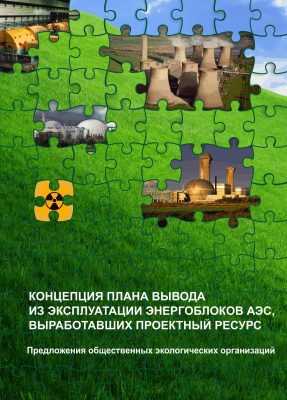4. Spent nuclear fuel (SNF)
Spent nuclear fuel is a special type of waste. SNF from RBMK reactors is kept in a temporary storage on the plant site.
The SNF of VVER-440 reactors is brought to the "Mayak” industrial company, facility RT-1 in the town of Ozersk, Chelyabinsk Oblast. Unlike Germany Russia reprocesses SNF from all VVER-440 reactors in one place.
The plant also takes SNF from Russian nuclear submarines and fast-breeder reactor BN-600.
The plant which has a design capacity of 400 t/year was put into operation in 1977.
The SNF coming to the plant is kept in the buffer storage of the 1440 t capacity. The SNF reprocessing gives the following products:
molten uranyl nitrate, the raw material for producing new fuel for the RBMK-1000 reactors;
plutonium dioxide goes to the storage facility (due to the lack of demand on it).
SNF is reprocessed by the technology of extraction, which produces a large volume of liquid RW.
For many years PO "Mayak” discharged huge volume of LRW into the environment.
This practice continues today. Every year about ~10 mln. m3 RW is discharged into the environment, which poses a threat not only to Chelyabinsk, but also to neighboring regions. It is also a threat to the seas of the Arctic Ocean, to which flow the rivers from the catchment area hosting SNF reprocessing facilities.
After an improvement of the technological process, the discharges of low- and middle-level liquid waste into water were reduced by 10%. Still, taking into account the catastrophic environmental situation resulting from PO "Mayak” operation (its radiochemical plants in particular), the Legislative Assembly of Chelyabinsk Oblast took a decision to restrict the production capacity of RT-1 facility by 50%.
This reduced an impact on the South Urals habitat, and resulted in the SNF accumulation on the temporary storage site of PO "Mayak”. This produces new problems for safe storage.
As SNF reprocessing requires still safer and more expensive technologies of its isolation, its reprocessing cost is not compensated by selling the regenerated uranium.
SNF of RBMK-1000 reactors is concentrated in the temporary storages near NPPs.
By now 9500 t of it has been accumulated.
Almost half of this is the SNF of Leningrad NPP.
Every year about 3000 spent fuel assemblies have been transferred to the temporary wet storage of the plant. Starting from 2005 Leningrad NPP uses uranium-erbium fuel, which has a 2,8 % enrichment. Its burnout resource is much larger. Therefore, the yearly dispatch of SNF to the storage will be reduced to 1000. It means that in case of the 15-year lifecycle extension of all four power units an additional number of fuel assemblies will be 15000.
At present LNPP is finishing the construction of a cutting unit for fuel assemblies.
Each half of an assembly, which is cut into two parts, will be placed into the metalconcrete container on the plant territory.
This will be the intermediate "dry” storage of SNF. Later, when the Krasnoyarsk Mining - Chemical Combine completes the national SNF storage, LNPP will start the transfer of its spent fuel there (up to 2300 assemblies annually).
Дополнительные материалы
This topic focuses on the existing experience of long-term isolation of radioactive wastes from the environment in Russia
Lectures on this topic:
- 01. Operational RW and SNF of Russian VVER and RBMK reactors
- 02. Generation of solid radioactive waste (SRW)
- 03. Recycling of metallic radioactive waste
- 04. Spent nuclear fuel (SNF)
- 05. Radioactive waste produced at NPP decommissioning
- 06. Necessity of establishing a unified RW management system
- 07. Proposals for establishing regional RW repository in the North-West Russia
- 08. Legal provisions for RW management in Russia
- 09. Importance of using the international experience of RW and SNF management
- 10. European experience
TOPIC OF COURSE
- Topic 01. Current condition of nuclear energy
- Topic 02. Legislation in the US and in Russia
- Topic 03. International law in the sphere of decommissioning
- Topic 04. Role of the national regulators in the decommissioning process
- Topic 05. Possible approaches and scenarios of decommissioning
- Topic 06. Existing experience of decommissioning
- Topic 07. Strategy for handling radioactive waste (RW) and spent nuclear fuel (SNF) USA experience
- Topic 08. Strategy for handling RW and SNF Russian experience & other countries
- Topic 09. Social aspects of decommissioning
- Topic 10. International and inter-regional cooperation for safe decommissioning
